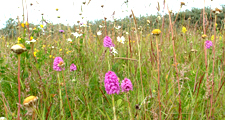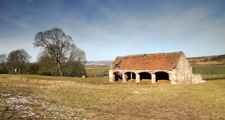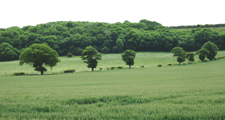Limestone Escarpment
Land Management
Natural Features, Watercourses and Wetlands
- Protect natural and artificial ponds from drainage or infilling. Restore former field ponds and create new ponds on suitable sites.
Farmland
- Protect and conserve magnesian limestone grasslands. Adopt grazing or cutting regimes which maximise their biodiversity and prevent encroachment by scrub. Avoid improvements such as drainage, ploughing and reseeding and limit the use of fertilisers and herbicides.
- Restore former limestone grasslands and create new species rich limestone and neutral grasslands on suitable sites, and particularly where they buffer, extend or link existing grasslands. Use seed or hay crops from local sources.
- Protect and conserve limestone plant communities in abandoned quarries, road verges and waste ground.
- Establish uncultivated margins along hedgerows, woodland edges and watercourses. Avoid cultivation under the canopy of hedgerow trees.
Trees, Woodlands and Forestry
- Protect, conserve and extend existing ancient woodlands.
- Restore modified or replanted ancient woodlands by progressively removing non-native species. Restock or extend using natural regeneration or planting native species of local origins.
- Plant new small and medium sized broadleaved woodlands (ash on limestone, oak on boulder clay) and particularly on steeper slopes, in denes and dry valleys, and around settlement edges.
- Progressively restructure softwood plantations – particularly those of reclaimed land – to create new native ash and oak woodlands.
- Plant small woodlands and tree groups to screen larger modern farm buildings.
- Protect and maintain existing hedgerow trees. Plant new field boundary trees (Ash, Common Oak) – and particularly on restored opencast land – or tag saplings to replace the maturing stock.
Cultural Features
- Protect archaeological features including rigg and furrow from damaging activities such as cultivation, tree planting or poaching by stock.
- Conserve and maintain parkland relics, respecting designed elements and veteran trees.
- Conserve and maintain traditional field barns and farm buildings.
Field Boundaries
- Protect and maintain hedgerows. Renovate overgrown and gappy hedges by laying or coppicing and gapping up.
- Allow trimmed hedges to grow higher and broader. Consider trimming every second or third year rather than annually.
- Reinstate hedges where they have been replaced by fences – particularly on steeper spur and vale sides.
Development
Agricultural Buildings
- Site new farm buildings close to existing buildings where possible, and reflect their scale, character and materials. Avoid steeply sloping sites. Reduce the impact of larger modern buildings by careful selection of colour, breaking up mass and planting screening belts of native species.
Energy, Telecommunications and Infrastructure
- Site communications masts on buildings in urban areas where possible – or close to existing buildings, tree groups or woodland edges in the open countryside.
- Avoid the siting of tall structures such as communication masts, pylons and wind turbines on prominent local skylines and particularly escarpment spurs and those areas forming a backdrop in important views of Durham Cathedral.
- Give careful consideration to the siting, layout and design of new wind energy developments having particular regard to cumulative impacts, the relationships of nearby developments in terms of turbine size and type, and impacts on the setting of the Durham Cathedral and Castle World Heritage Site.
- Avoid ‘urban’ detailing and street lighting on country roads.
Housing and Economic Development
- Maintain the separation of towns and villages and the rural character of the countryside between them in planning for new development.
- Screen any new development on settlement edges with substantial structure planting of native ash woodland. Avoid prominent sloping sites for new development or incorporate substantial internal structure planting.
- Avoid ridgeline development on the escarpment and particularly in those areas forming a backdrop in important views of Durham Cathedral.
Minerals and Waste
- Avoid damage to sensitive natural landforms, mature landscape features and semi-natural habitats in selecting and operating mineral sites.
- Restore quarry faces to naturalistic profiles using restoration blasting.
- Restore quarries and landfill sites to native ash woodland, limestone grassland, wetland and bare rock habitats. Retain areas of disturbed ground, cliff faces, scree slopes and quarry wastes to maximise botanical diversity.
- Minimise visual impacts in the working of quarries through careful site design and the use of on and off-site structure planting, road and path side hedges.
- Adopt low intervention approaches to the reclamation of former colliery and industrial land where possible to preserve the landscape’s industrial heritage and ‘brownfield’ biodiversity.
Tourism and Recreation
- Tourism and recreational development should be undertaken in such a way as to avoid any urbanising influence on the landscape.
- Golf course development should seek to conserve and reinforce landscape character by retaining mature landscape features and planting new native woodlands and parkland trees. Avoid prominent locations for built elements like buildings, driving ranges and ball-trap fencing. Develop species limestone or neutral grassland in roughs to increase biodiversity.
- Equestrian facilities should be sited close to existing farm buildings where possible, and reflect their scale, character and materials. The impact of larger buildings should be reduced by careful selection of colour, breaking up mass, and planting screening belts of native woodland.



